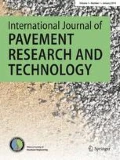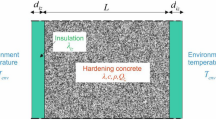Abstract
The shortcoming of the available laboratory methods for determining the moisture susceptibility of asphalt mixtures has led researchers to think about providing new methods based on effective parameters on moisture damage process. Accordingly, this research is an attempt to provide a prediction model using thermodynamic and mix design parameters that can predict and analyze the performance of asphalt mix against moisture. T he results of this study indicate that the use of anti-stripping additives can generally improve the performance of asphalt mixtures against moisture; however, the type and percentage of these additives should be determined according to the type of aggregate, the type of bitumen and the properties of the mixing plan of the asphalt mix. Based on the proposed model, it can be stated that an increase in cohesion free energy, adhesion free energy, aggregate wettability by bitumen, surface area of aggregates, and apparent asphalt film thickness on the aggregate surface improve the moisture resistance of mixtures. On the other hand, debonding energy, saturation percentage, and permeability negatively affect the asphalt mixture’s resistance to moisture damage.
Similar content being viewed by others
References
Q. J. Li, S. P. Minnekanti, G. Yang, C. Wang, Traffic inputs for pavement ME design using Oklahoma data, Inter. J. Pavement Res. Technol. 12 (2) (2019) 154–160.
J. De Visscher, A. Vanelstraete, Ravelling by traffic: Performance testing and field validation, Inter. J. Pavement Res. Technol. 10 (1) (2017) 54–61.
G. H. Hamedi, S. A. Tahami, The effect of using anti-stripping additives on moisture damage of hot mix asphalt, Inter. J. Adhesion Adhesives 81 (2018) 90–97.
S. Caro, E. Masad, A. Bhasin, D. N. Little, Moisture susceptibility of asphalt mixtures, Part 1: mechanisms, Inter. J. Pavement Eng. 9 (2) (2008) 81–98.
L. G. Cucalon, E. Kassem, D. N. Little, E. Masad, Fundamental evaluation of moisture damage in warm-mix asphalts, Road Mater. Pavement Des. 18 (sup1) (2017) 258–283.
G. H. Hamedi, F. M. Nejad, Evaluating the effect of mix design and thermodynamic parameters on moisture sensitivity of hot mix asphalt, J. Mater. Civ. Eng. 29 (2) (2016) 04016207.
J. S. Chen, K. Y. Lin, S. Y. Young, Effects of crack width and permeability on moisture-induced damage of pavements, J. Mater. Civ. Eng. 16 (3) (2004) 276–282.
R. G. Hicks, Moisture damage in asphalt concrete. Transp. Res. Board, Washington DC, USA, Vol. 175, 1991.
M. Arabani, S. A. Tahami, G. H. Hamedi, Performance evaluation of dry process crumb rubber-modified asphalt mixtures with nanomaterial, Road Mater. Pavement Des. 19 (5) (2018) 1241–1258.
G. H. Hamedi, Investigating the use of nano coating over the aggregate surface on moisture damage of asphalt mixtures, Inter. J. Civ. Eng. 16 (6) (2018) 659–669.
J. Epps, E. Berger, J. N. Anagnos, Treatments, Moisture Sensitivity of Asphalt Pavements- A National SeminarCalifornia Department of Transportation; Federal Highway Administration; National Asphalt Pavement Association, California Asphalt Pavement Alliance; and Transp. Res. Board, San Diego, California, USA, 2003.
American Materials and Testing Association, Standard Practice for Effect of Water on Bituminous-Coated Aggregate Using Boiling Water. ASTM D3625 / D3625M-12. ASTM International, West Conshohocken, PA, 2012.
American Materials and Testing Association, Test Method for Coating and Stripping of Bitumen-Aggregate Mixtures. ASTM T182. ASTM International, West Conshohocken, PA, 2012.
P. S. Kandhal, Moisture susceptibility of HMA mixes: identification of problem and recommended solutions. No. NCAT 92–1. National Asphalt Pavement Association, Lanham, MD, USA, 1992.
American Materials and Testing Association, Standard Test Method for Effect of Water on Compressive Strength of Compacted Bituminous Mixtures. ASTM D1075–11. ASTM International, West Conshohocken, PA, 2011.
American Materials and Testing Association, Standard Test Method for Effect of Moisture on Asphalt Concrete Paving Mixtures. ASTM D4867 / D4867M-09(2014). ASTM International, West Conshohocken, PA, 2014.
A. R. Copeland, Influence of moisture on bond strength of asphalt-aggregate systems, (Doctoral dissertation), Vanderbilt University, Nashville, Tenn, USA, 2007.
M. Solaimanian, J. Harvey, M. Tahmoressi, V. Tandon, Test methods to predict moisture sensitivity of hot-mix asphalt pavements, Moisture Sensitivity of Asphalt Pavements-A National SeminarCalifornia Department of Transportation; Federal Highway Administration; National Asphalt Pavement Association; California Asphalt Pavement Alliance; and Transp. Res. Board, San Diego, California, USA, 2003.
P. E. Sebaaly, Comparison of lime and liquid additives on the moisture damage of hot mix asphalt mixtures, National Lime Association, Arlington, Virginia, USA, 2007.
P. Chaturabong, H. U. Bahia, The evaluation of relative effect of moisture in Hamburg wheel tracking test, Constr. Buil. Mater. 153 (2017) 337–345.
U. M. Arepalli, N. M. Kottayi, R. B. Mallick, Moisture susceptibility evaluation of Hot Mix Asphalt: combined effect of traffic and moisture, Inter. J. Pavement Res. Technol. 12 (2) (2019) 206–214.
M. Fakhri, H. Maleki, S. A. Hosseini, Investigation of different test methods to quantify rutting resistance and moisture damage of GFM-WMA mixtures, Constr. Buil. Mater. 152 (2017) 1027–1040.
G. H. Hamedi, F. M. Nejad, Use of aggregate nanocoating to decrease moisture damage of hot mix asphalt, Road Mater. Pavement Des. 17 (1) (2016) 32–51.
G. H. Hamedi, Evaluating the effect of asphalt binder modification using nanomaterials on the moisture damage of hot mix asphalt, Road Mater. Pavement Des. 18 (6) (2017) 1375–1394.
A. Azarhoosh, F. M. Nejad, A. Khodaii, Evaluation of the effect of nano-TiO2 on the adhesion between aggregate and asphalt binder in hot mix asphalt, European J. Environ. Civ. Eng. 22 (8) (2018) 946–961.
C. J. Van Oss, M. K. Chaudhury, R. J. Good, Interfacial Lifshitz-van der Waals and polar interactions in macroscopic systems, Chem. Rev. 88 (6) (1988) 927–941.
R. J. Good, C. J. van Oss, The modern theory of contact angles and the hydrogen bond components of surface energies, Modern approaches to wettability, Springer, Boston, MA, 1992. 1–27.
D. Myers, Surfaces, interfaces, and colloids, New York etc.: Wiley-Vch, Weinheim, Germany, Vol. 358, 1999.
L. F. M. Da Silva, A. Öchsner, R. D. Adams, eds. Handbook of adhesion technology, Springer Science, Business Media, Heidelberg, Germany, 2011.
American Materials and Testing Association, Standard Test Method for Determining the Resilient Modulus of Bituminous Mixtures by Indirect Tension Test. ASTM D7369–11. ASTM International, West Conshohocken, PA, 2011.
D. W. Christensen, R. F. Bonaquist, Volumetric Requirements for Superpave Mix Design. NCHRP Report 567, Transp. Res. Board of the National Academies: Washington, DC, USA (2006).
E. Masad, B. Birgisson, A. Omari, A. Cooley, Analysis of permeability and fluid flow in asphalt mixes, J. Mater. Civ. Eng. 16 (5) (2004).
American Materials and Testing Association, Standard Provisional Test Method for Measurement of Permeability of Bituminous Paving Mixtures Using a Flexible Wall Permeameter. ASTM PS129–01. ASTM International, West Conshohocken, PA, 2001.
D. N. Little, A. Bhasin, A. Hefer, Using surface energy measurements to select materials for asphalt pavement. NCHRP project 9–37. Transp. Res. Board, Washington, DC, USA, 2006.
A. Bhasin, D. N. Little, Characterization of aggregate surface energy using the universal sorption device, J. Mater. Civ. Eng. 19 (8) (2007) 634–641.
A. W. Hefer, A. Bhasin, D. N. Little, Bitumen surface energy characterization using a contact angle approach, J. Mater. Civ. Eng. 18 (6) (2006) 759–767.
Author information
Authors and Affiliations
Corresponding author
Additional information
Peer review under responsibility of Chinese Society of Pavement Engineering.
Rights and permissions
About this article
Cite this article
Nejad, F.M., Asadi, M. & Hamedi, G.H. Determination of moisture damage mechanism in asphalt mixtures using thermodynamic and mix design parameters. Int. J. Pavement Res. Technol. 13, 176–186 (2020). https://doi.org/10.1007/s42947-019-0099-8
Received:
Revised:
Accepted:
Published:
Issue Date:
DOI: https://doi.org/10.1007/s42947-019-0099-8




